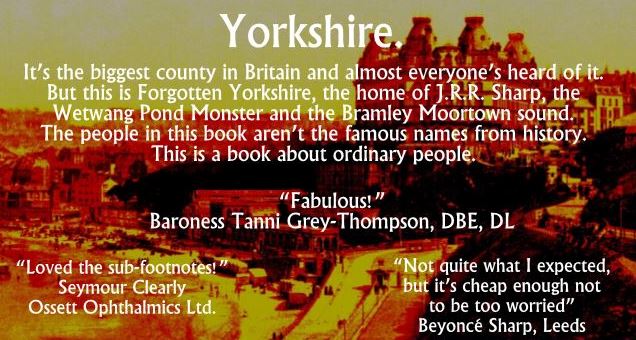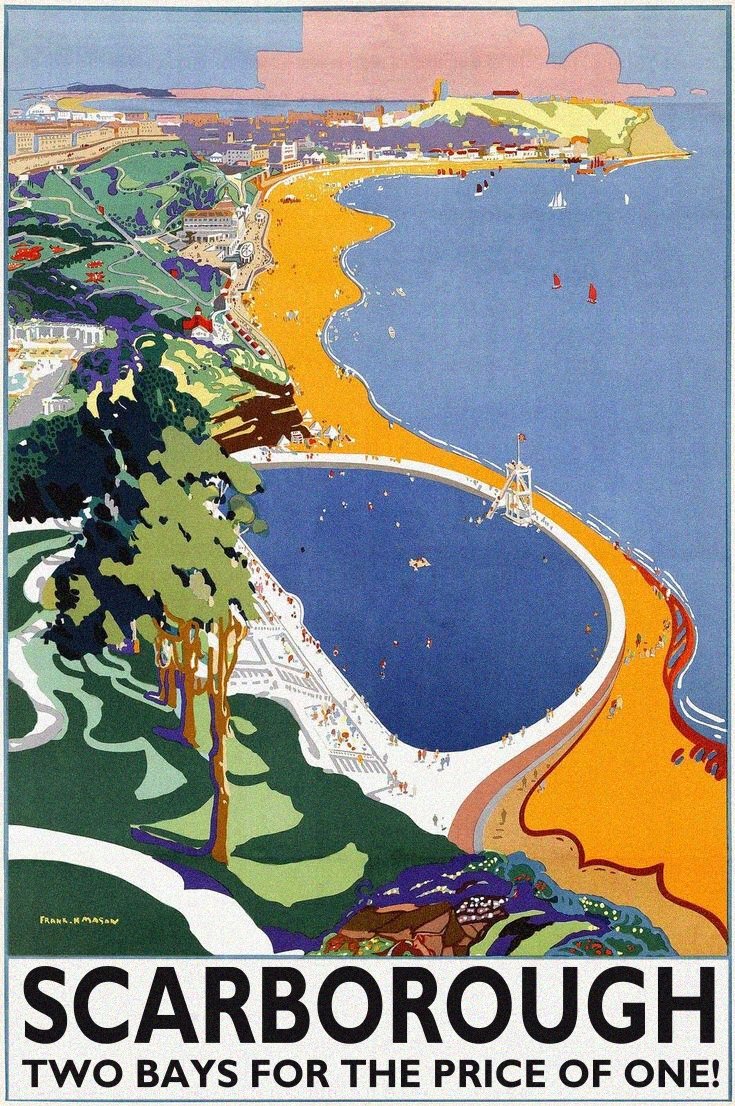LET& #39;S VISIT SCARBOROUGH! (Thread courtesy of Dr Eric K Shipley.)
Scarborough is Yorkshire’s largest seaside resort, and is even said by some more imaginative observers to be the world’s first. (1)
Scarborough is Yorkshire’s largest seaside resort, and is even said by some more imaginative observers to be the world’s first. (1)
‘Skarðaborg’ is reputed to have been founded in 966 by a Viking, Thorgils Skarthi, who had evidently grown tired of demolishing other people’s towns, and decided to have a go at building one of his own.
This seems to have outraged his colleagues, and one Tostig Godwinson reverted to traditional practice and burnt it down again. (2)
Thus, at the time in 1085 when William the Conqueror’s surveyors reached ‘S’ in the Domesday Book (3) there was, as the great document records, ‘naffe all’ to be listed, as much of the town lay in ruins.
Two English monarchs were responsible for Scarborough’s later recovery.
Two English monarchs were responsible for Scarborough’s later recovery.
King Henry II built a small castle on the beach, but unfortunately the tide came in, so instead he built a much larger one on the headland that dominates the town.
Edward II subsequently granted Scarborough Castle to his particular friend Piers Gaveston, (4) who eventually became so influential that a number of murderous barons intervened, after which much of Gaveston lay in ruins. (5)
In the 13th century, a Royal Charter granted Scarborough the right to hold a great trading fair (or ‘Fayre’, as the antique dealers and olde tea shoppes preferred it) which lasted for 500 years, by which time the beer tent really had run out.
This event is of course commemorated in the song Scarborough Fair. (6) Scarborough then changed hands several times during the English Civil War, following which much of the town lay (once again) in ruins.
In the 17th century. a local lady found water flowing from beneath the cliff to the south of the town. Noting that this water was staining the rock an unsightly red-brown colour, she unaccountably failed to call the environmental heath inspectors and instead tasted the water.
Acting on the ‘cough-mixture principal’ (anything that tastes so bad must be good for you) (7) she announced its virtues to the world, and those suffering from a bad case of nothing better to do were soon flocking to the town.
By the early 1700s business was so good that a predecessor of the present day Spa complex had been constructed, but after a major cliff-fall in 1737, much of the site lay in ruins. (8)
By 1858, the Spa had become a consider-able development, with new buildings designed by Joseph ‘The Inflammable’ Paxton, (9) the architect of the Crystal Palace, whilst in 1875 a funicular railway (10) was built to connect it with the esplanade on the cliff top.
Unaccountably, the following year witnessed a bad fire after which much of the site (though sadly not the career of Paxton) lay in ruins.
Earlier, in 1845, Scarborough had acquired both its first hotel, and a railway link to York, (11) and visitor numbers grew throughout the Victorian era.
During the First World War, the town and the castle were bombarded by German warships (as was nearby Whitby Abbey) after which much of the site lay in ruins.
A particular characteristic of the town has always been the way in which the promontory on which the castle stands, effectively divides the seafront into two, the North and South bays.
This was an especially attractive feature to Yorkshire holidaymakers, the prospect of two bays for the price of one proving almost irresistible.
The South Bay is dominated by the Grand Hotel which, when completed in 1867, was one of the largest hotels in the world. Its four towers represented the seasons, 12 floors the months, 52 chimneys the weeks and 365 bedrooms the days of the year.
However, the early custom of building and demolishing a leap-bedroom every fourth year is no longer practised. (12)
The North Bay is noted in particular for the Japanese-themed Peasholm Park, (13) complete with its own pagoda and oriental bridge. (14)
The park’s lake is regularly used to present a model re-enactment of the Battle of the River Plate, and of all the world’s imitation South American naval encounters in Japanese surroundings, this is frequently said to be the most realistic.
Scarborough gained worldwide attention most recently in 1993, when a landslip caused part of the Holbeck Hall Hotel to fall into the sea. After which the remainder of the hotel lay in ruins.
FOOTNOTES
1. This claim is hotly disputed, for example by Blackpool and Brighton. But what would you expect from Lancastrians and Southerners?
2. The suggestion that the town was then revived again by Sandi Toksvig, a small beach-loving Viking, has no apparent foundation.
1. This claim is hotly disputed, for example by Blackpool and Brighton. But what would you expect from Lancastrians and Southerners?
2. The suggestion that the town was then revived again by Sandi Toksvig, a small beach-loving Viking, has no apparent foundation.
3. The name of the book is not, as commonly supposed, related to ‘Doomsday’. In fact, it comes from the Latin Domestos, meaning to tax 99% of all known peasants.
4. Historians believe that it was around this time that the phrase ‘Queen of the East Coast’ was first used in a Scarborough-related context.
5. Piers Gaveston appears to have visited a large number of seaside towns in his career, since many still have large horizontal erections named in his honour He also gave his name to a popular brand of indigestion tablet.
6. Note to budding songwriters: if you’re struggling with a line, just bung ‘Parsley, Sage, Rosemary and Thyme’ in there at random. It works every time:
‘When I find myself in times of trouble
Parsley, Sage, Rosemary and Thyme’
Parsley, Sage, Rosemary and Thyme’
‘Is this the real life,
Is this just fantasy,
Caught in a landslide,
Parsley, Sage, Rosemary and Thyme’
Is this just fantasy,
Caught in a landslide,
Parsley, Sage, Rosemary and Thyme’
‘How many roads must a man walk down
Parsley, Sage, Rosemary and Thyme’
Parsley, Sage, Rosemary and Thyme’
7. ‘Tastes Like it’s Good For You!’ was the strapline for a magazine ad promoted by the British Tripe Council in 1957.
8. That it reopened in only a few weeks points to the extraordinary popularity of drinking diluted battery acid in this period.
8. That it reopened in only a few weeks points to the extraordinary popularity of drinking diluted battery acid in this period.
9. Paxton’s Crystal Palace was, of course, a huge building made almost entirely from glass and iron, whilst Scarborough Spa was specifically designed to house lots of water. Both somehow managed to burn down.
10. The exact shade is unknown, but in fact most visitors appear to have considered it a perfectly normal colour.
11. Scarborough station boasts the longest railway station bench in the world. At 139 metres it is capable of seating over 60 American tourists in comfort.
11. Scarborough station boasts the longest railway station bench in the world. At 139 metres it is capable of seating over 60 American tourists in comfort.
12. Betjeman Sharp (see pp. 23-25) was famously barred from the hotel after writing that ‘24 hours represents the longest anyone should ever stay in this unlovely place and 60 minutes the waiting time between ordering a meal and its arrival.’
13. Peasholm Park forms part of the estate of the Manor of Northstead. Stewardship of the manor, like that of the better known Chiltern Hundreds, is a post that MPs apply for when they wish to resign and do something useful. own.
It carries no salary and has no duties, but is a useful way of keeping the unemployment figures down.
14. The number of Yorkshire-themed gardens in Japan is not currently kn
14. The number of Yorkshire-themed gardens in Japan is not currently kn
We hope you have enjoyed reading this extract from @ForgottenYorks (and parts of Derbyshire and North Humberside) by Dr Eric K Shipley, published by @TMB_Books.
If you yearn for more, it& #39;s available here: https://tripemarketingboard.co.uk/forgotten-yorkshire-tmb.php">https://tripemarketingboard.co.uk/forgotten...
If you yearn for more, it& #39;s available here: https://tripemarketingboard.co.uk/forgotten-yorkshire-tmb.php">https://tripemarketingboard.co.uk/forgotten...
Visit http://www.tripemarketingboard.co.uk/tripe-gifts ">https://www.tripemarketingboard.co.uk/tripe-gif... for a special offer on @ForgottenYorks!

 Read on Twitter
Read on Twitter






